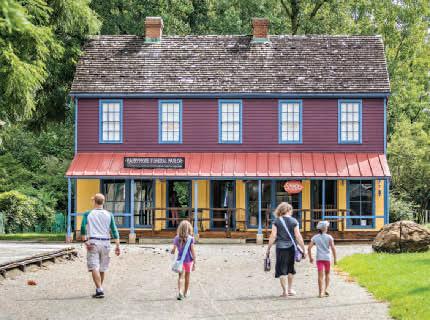
20 minute read
In the News
Historic Preservation
National Register Adds Ohio History Center & Ohio Village
The Ohio History Connection has been involved in nominating properties across the Buckeye State to the National Register of Historic Places since 1966. Now our own headquarters at I-71 & 17th Avenue in Columbus, built between 1966 and 1970, has been added to the National Register, along with Ohio Village, completed in 1974.
The Register is the nation’s official list of properties recognized by the federal government as worthy of preservation for local, state or national significance in American history, architecture, archaeology, engineering or culture.
Iconic Architecture
“Recognition on the National Register brings well-deserved attention to the iconic architecture of the Ohio History Center,” says Megan Wood, Ohio History Connection executive director and CEO.

Designed by W. Byron Ireland & Associates of Columbus, the center opened in 1970. It was hailed at the time as a “bold, imaginative, almost startling structure” and “no doubt the most architecturally significant structure built in Ohio since the State Capitol.”
A Columbus native, Ireland graduated from Harvard Graduate School of Design, then worked in the offices of renowned Detroit architect Eero Saarinen until Saarinen’s death at age 51 in 1961. Saarinen’s firm designed many well-known modernist landmarks, such as Dulles International Airport in Virginia, the Gateway Arch in
St. Louis and the TWA Terminal at New York’s JFK Airport.
The Ohio History Center is two structures in one: a museum on the ground floor, and a library and archives on floors three through five, linked by a glass-enclosed plaza between them on floor two. Daniel Porter, director at the time, likened it to “a sandwich.” The museum has a triangular floor plan, reflecting its three emphases at the time—history, archaeology and natural history. The library and archives floor plan is a square “doughnut,” with a sky-lit reading room open three stories in the “hole.”
The Builders Exchange of Central Ohio recognized Setterlin Building Company’s crew for their skill and ingenuity in executing the poured-inplace concrete of what was a novel structure at the time. Engineering the 40-foot cantilevers involved an early use of computers by Korda Engineering.
Interiors feature dark oak woodwork, board-formed terrazzo floors, coffered concrete ceilings and skylights. The choice of the modern style was intentional, to serve as a foil for the artifacts that the building houses, some of them thousands of years old.
Designed For Teaching
Adjacent Ohio Village, a recreated 19th-century community designed for living history programs, was in the plan from the start and opened in 1974. Surrounding a village green, its 19 buildings are modeled after a typical pre-Civil War Ohio town. Cleveland architect Robert C. Gaede FAIA, an early advocate for preserving Ohio’s architectural heritage, was involved in planning it.
Past Meets Future
“The Ohio History Center & Ohio Village created two architectural expressions—one ultra-modern, anticipating Ohio’s future, and one looking to Ohio’s past—and both designed to achieve the Ohio History Connection’s mission of preserving and sharing stories of our state and its history,” says architectural historian Barbara Powers of the Ohio History Connection’s State Historic Preservation Office. Her staff took on the job of preparing the National Register nomination as a team project. The American Institute of Architects (AIA) awarded the Ohio History Center a design prize in 1972, and in 1994 honored the building with an AIA 25-year award recognizing its enduring excellence in architectural design and engineering.
Historically, the Ohio History Center & Ohio Village are associated with a major period of state-funded construction for Ohio’s historic sites and other public works during the administration of Gov. James A. Rhodes from 1963 to 1971.
From Our Director
Offering field services to history-related organizations throughout Ohio is one of our responsibilities outlined in the Ohio Revised Code, state law.
This is not to imply that we know everything. Often it means bringing those active in local history together to share best practices. Since 1959, the Ohio History Connection and the Ohio Local History Alliance have partnered to bring interested professionals and active volunteers together for annual regional meetings and a yearly statewide meeting.
A membership organization, the Ohio Local History Alliance has always operated with support from our local history office. Our joint mission is to encourage efforts to collect, preserve and interpret local history via a network of history-related organizations. The alliance offers great programming and support, including workshops, grants and a bimonthly newsletter, The Local Historian, for the more than 700 such organizations in our state. (Learn more at ohiolha.org.)
In March, I had the opportunity to visit two of the regional meetings. The Ohio Local History Alliance organizes Ohio into 10 regions. Central Ohio’s regional meeting was in Newark. The day began in the National Heisey Glass Museum in Veterans’ Park, a beautiful setting where you can find several history-related museums and attractions. There I heard a moving presentation about a project run by Licking County Library Program Manager Doug Stout, who’s working to uncover, share and honor stories of local veterans. For lunch, we moved to another historic venue in the park, Licking County Historical Society’s Buckingham Meeting House.
I recently joined the board of Licking County’s Dawes Arboretum, so I ended my day with a quick hike to see some of the spring flowers. If you love history and the outdoors, I recommend a stop there before or after exploring Newark Earthworks or The Works museum, or having a meal in Newark’s lovely historic downtown.
Later, I drove north to Loudonville’s Cleo Redd Fisher Museum, taking a scenic route through Fredericktown and around Mohican State Park. The museum has an interesting collection, and I learned about The College of Wooster’s digital history project and its internship program, both inspirational. Wooster faculty are working with area history professionals to create meaningful internships for students who benefit the organizations where they’re placed.
These experiences make me proud to be part of a community of professionals and active volunteers who care so deeply about our state, our history and our future. If you want to support history in Ohio, become a member of your local history organization and make it a habit to visit historic sites. I promise it will bring you joy and enlightenment.
Megan Wood | Executive Director & CEO, Ohio History Connection
WORLD HERITAGE UNESCO Committee Will Consider Ohio’s Hopewell Ceremonial Earthworks in September

The World Heritage Committee of UNESCO, the United Nations Educational, Scientific and Cultural Organization, will consider the proposed nomination of Ohio’s Hopewell Ceremonial Earthworks for designation as a World Heritage Site when it meets in Riyadh, Saudi Arabia, Sept. 10–25, 2023.
Representatives From 21 Nations
The nomination for the Hopewell Ceremonial Earthworks is one of 58 worldwide that the committee will consider. The UNESCO World Heritage Committee comprises representatives from 21 nations, elected from the members of the UNESCO World Heritage Convention. Advised by the International Council on Monuments and Sites (ICOMOS), it makes the final decision on nominations.
Jen Aultman, chief historic sites officer for the Ohio History Connection, and Brad Lepper, the Ohio History Connection’s World Heritage Program senior archaeologist, have been actively involved in preparing the nomination and seeking the designation. The September meeting represents the culmination of years of work for both, and both are optimistic that the World Heritage Committee will act to approve the proposed nomination.
Eight Ancient Earthworks
The nomination for Ohio’s Hopewell Ceremonial Earthworks encompasses eight earthworks that ancient American Indians built about 2,000 years ago: Fort Ancient Earthworks & Nature Preserve, near Oregonia and Lebanon; Newark’s Great Circle and Octagon; and Hopewell Mound Group, Mound City, Hopeton Earthworks, Seip Earthworks and High Bank Works, all near Chillicothe.
On July 24, Ohioans have a special opportunity to tour Newark’s Octagon Earthworks, which are fully open just four days a year. (See page 19.)
Newark’s Great Circle Earthworks and Fort Ancient near Lebanon are open to visitors on a regular basis under the auspices of the Ohio History Connection (ohiohistory. org/newark and ohiohistory.org/ fortancient). Ohio History Connection members enjoy free admission. The five Hopewell earthworks sites in the Chillicothe area are also open to visitors on a regular basis under the auspices of the National Park Service (nps.gov/hocu/index.htm).
If approved by the World Heritage Committee in September, the Hopewell Ceremonial Earthworks would become Ohio’s first World
Heritage Site and the 25th in the United States. There are 1,157 UNESCO World Heritage Sites worldwide, among them Stonehenge, the Great Wall of China and the Pyramids of Egypt. Learn more and explore the World Heritage List at whc.unesco.org/en/list
Natural History
Glacial Grooves Transferred
The Ohio History Connection has transferred ownership and operation of its Glacial Grooves Geological Preserve on Kelleys Island to the Ohio Department of Natural Resources.
“The Ohio Department of Natural Resources has been our Glacial Grooves site management partner for many years, and also manages Kelleys Island State Park adjacent to Glacial Grooves,” says Jen Aultman, chief historic sites officer for the Ohio History Connection. “The department also has expertise in geology and natural history, and our staff worked with ODNR on recent site upgrades and reinterpretation. We feel confident in their stewardship of the site.”
A National Natural Landmark, Glacial Grooves Geological Preserve is at the north end of Division Street on Kelleys Island. It remains open to visitors. A walkway and stairs offer great views of the deep grooves that a glacier scoured into solid limestone about 18,000 years ago, plus marine fossils that are 350 to 400 million years old.
JULY 26–AUG. 6
Ohio History at the Ohio State Fair
This year, Ohio State Fair goers will be able to get a side of Ohio history with their corndogs and deep-fried Twinkies.
All fairgoers will be able to visit the Ohio History Center & Ohio Village free with their daily admission tickets July 26 through Aug. 6, 10 a.m. to 5 p.m.
“We’re so excited to be able to share Ohio’s stories with more Ohioans during the fair,” says Jen Cassidy, director of the Ohio History Center & Ohio Village.
The Ohio History Center & Ohio Village will be open for members as always. Additionally, Ohio History Connection members will enjoy discounts on Ohio State Fair tickets. Just show your Ohio History Connection membership card at the fair gate and receive two FREE admission tickets.
Tickets must be acquired in person at the fair gate, and you must have your membership card. The offer is not valid for tickets purchased online or in advance. Lost your card? Contact our membership department at 800.686.1545 or membership@ ohiohistory.org to get a replacement. Visit ohiohistory.org/statefair for all the latest information about Ohio History Center & Ohio Village programming, parking, discounts and more. We hope to see you there!
OHIO MUSEUMS ASSOCIATION Zoar, Armstrong Earn Awards
Congratulations are in order for two Ohio History Connection sites, Armstrong Air & Space Museum in Wapakoneta, and Zoar Village in Zoar, that are among recent recipients of the Ohio Museums Association’s annual Awards of Achievement and Visual Communication Awards.
Zoar Village received an Institutional Achievement Award for Best Education and Outreach for its Zoar and the Presidents School Day program, which teaches students about U.S. presidents who served during the years when Zoar was the home of a communal society of German religious separatists, from 1817 to 1898. Reenactors portray presidents such as William McKinley, who visited Zoar often, and Abraham Lincoln. Students take part in presidential trivia and make their own campaign signs.
Armstrong Air & Space Museum received two Visual Communication Awards, a Gold Award for its virtual museum tour and a Silver Award for its 50th anniversary logo. Learn more about the virtual tour at armstrongmuseum.org
The Ohio Museums Association awards celebrate notable accomplishments by Ohio museums in visual communications, individual and institutional achievement and the work museum professionals undertake to help advance Ohio’s museum community locally and on a national level.
HISTORIC PRESERVATION Grant Furthers Preservation Efforts
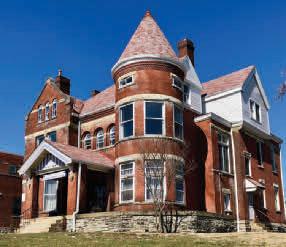
The Ohio History Connection’s State Historic Preservation Office has received a $74,982 Underrepresented Communities Grant from the National Park Service.
“This grant will further our goal of adding more Ohio places associated with significant themes in 20thcentury Black history to the National Register,” says Diamond Crowder, underrepresented communities survey and National Register manager for the State Historic Preservation Office. “It will also help in our efforts to build awareness and partnerships with African American Ohioans and organizations.”
Work Already Underway
The Ohio History Connection received a similar grant of $50,000 in 2021. Work made possible by the new grant will further efforts already underway to nominate eligible properties associated with significant themes in 20th-century Black history in Ohio, such as race relations and civil rights, African American women, Green Book properties and Black churches.
Among outcomes of the new grant, Youngstown’s West Federal Street YMCA and Cleveland’s Fellowship Missionary Baptist Church will be nominated to the National Register. In service from 1931 to 1974, the YMCA was built with support from the Julius Rosenwald Fund. Established by the president of Sears, Roebuck & Co., the fund aided projects for “the well-being of mankind,” among them construction of 22 YMCA/YWCA community centers and urban dormitories for Blacks in the U.S. The West Federal Street YMCA was among Ohio accommodations listed in the Negro Motorist Green Book of the 1930s to 1960s.
Leaders of Cleveland’s Fellowship
Missionary Baptist Church, organized in 1962, partnered with Dr. Martin Luther King Jr. during the Civil Rights Movement of the 1960s to combat racism, segregation and discrimination in Cleveland.
Cincinnati’s C.H. Burroughs House, already on the National Register as a work of local architect Samuel Hannaford (1835–1911), will have its nomination amended to add its history since 1925 as headquarters of the Cincinnati Federation of Colored Women’s Clubs, one of the oldest such organizations in the U.S., founded in 1904.
Awarded On A Competitive Basis
The grants, awarded on a competitive basis, come from the federal Historic Preservation Fund administered by the National Park Service. The fund derives its income from the sale of offshore oil-drilling leases. Money from depletion of one natural resource is used to further preservation of other natural and cultural resources. Since 2014, the Underrepresented Communities Grants Program has provided $5.75 million to better preserve and share stories of all Americans.
Historic Preservation
Recent Ohio Additions to the National Register of Historic Places
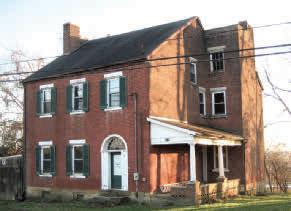

BEREA • CUYAHOGA COUNTY
CARL DROPPERS HOUSE
345 Prospect Rd.
Architect Carl Droppers (1918–2010) designed this steel-and-glass International Style house in the early 1960s and built it as his home in 1965. A master architect who practiced in Cleveland and taught at Western Reserve University, Droppers displayed innovation and forward thinking in the design, aided by structural engineer Richard M. Gensert (1922–2003), whose work made many important contributions to architecture in northeast Ohio, including engineering for the Blossom Music Center. Notable features of the Droppers House include steel I-beam columns and a cantilevered second floor. Living areas with walls of glass on all four sides overlook Wallace Lake, a Cleveland Metropark to the east.

CINCINNATI • HAMILTON COUNTY
EDWARD HART HOUSE
818 Glenwood Ave.
When Edward Hart (1855–1940) and family moved into this newly built home in Avondale in 1887, they were in the vanguard. Other well-to-do German Jewish families soon followed. By the 1920s, Avondale was home to three-fourths of Cincinnati’s Jewish population and a variety of Jewish institutions and businesses. Hart’s substantial Queen Anne-style house, designed by Cincinnati architect Gustave Drach (1861–1940), reflects his success in real estate and business.
In the late 19th and early 20th centuries, Hart was instrumental in shaping a theatre district around downtown’s Fountain Square, where he owned multiple vaudeville, burlesque and motion-picture theatres, among them the Bijou, Hippodrome (later Star, then Gayety) and Strand. He was part owner of two companies that lined up entertainment for other theatres, and co-owned a theatre management company. Fountain Square is still a focal point of downtown development. No vestige of Hart’s theatres remains. The home where he lived from 1887 to 1919 has been added to the National Register for its association with him.
CLEVELAND • CUYAHOGA COUNTY
CLEVELAND JEWISH CENTER-CORY
UNITED METHODIST CHURCH
1117 E. 105th St.
Built between 1920 and 1922, the Cleveland Jewish Center–Cory United Methodist Church is significant for its architecture, its association with the city’s Jewish history from 1922 to 1945 and its association with Cleveland’s African American history and the Civil Rights Movement after 1946. Architect
Albert F. Janowitz (1867–1937) designed the imposing block-long Neoclassical-style building, which served as the Cleveland Jewish Center and synagogue for Anshe
Emeth Beth Tefilo, the city’s largest Conservative congregation, from 1922 to 1945. It was the largest and most architecturally significant synagogue in the Glenville neighborhood, which was home to Cleveland’s largest Jewish population when it was built. Sold to Cory United Methodist Church in 1946, it became a center of civil rights organizing and activism, regularly hosting nationally known leaders of the Civil Rights Movement from 1954 to 1976. The well-preserved sanctuary retains many original features, including the pews, lighting, woodwork, stained glass and ornamental plasterwork with Judaic motifs. The wing historically used for recreation remains intact and in use as a recreation facility, including the original indoor pool.
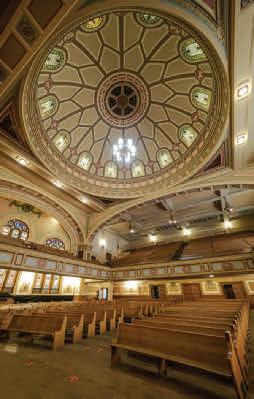
COLUMBUS • FRANKLIN COUNTY
OHIO HISTORY CENTER & OHIO VILLAGE
800 E. 17th Ave. (See page 6.)
FAIRVIEW • GUERNSEY COUNTY
MATTHEW SCOTT HOUSE
210 Fair Ave.
A “pike town” on Zane’s Trace and the National Road, the east-central
Ohio village of Fairview was once a destination for travelers west. Matthew Scott, an early merchant there, had migrated from Pennsylvania. He’s believed to have built this house sometime before 1834. A notable early Ohio example of the Federal style, it features a cut sandstone foundation; a Flemish-bond brick facade (every other brick is laid with the short side exposed, a costlier treatment that requires more bricks though results in an attractive pattern); a prominent door with halfround fanlight; windows with louvered wooden shutters; and decorative door and window surrounds, moldings and mantels. It is one of the few early houses remaining in Fairview.
FRANKLIN • WARREN COUNTY
FRANKLIN HISTORIC DISTRICT

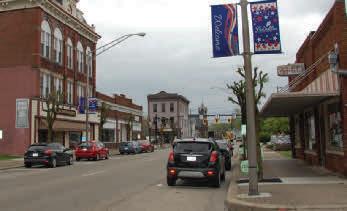
Roughly bounded by W. First, S. Main and Sixth Sts., and the Great Miami River Franklin is in the far northwest corner of Warren County, about 12 miles from
Lebanon, the county seat. The Franklin Historic District has been added to the National Register for its local historical and architectural significance. Founded in 1796 and incorporated in 1814, Franklin prospered over the years through the influence of the Miami and Erie Canal, the railroad, five different papermaking factories and, from 1896 to 1968, the Miami Valley Chautauqua. The district, which largely encompasses Franklin’s original 1796 plat, includes commercial, institutional and residential buildings that illustrate the town’s development over both centuries and features architectural styles of the 1850s to 1979, as well as some vernacular building forms from the early 1800s.
MIDDLETOWN • BUTLER COUNTY
OAKLAND RESIDENTIAL HISTORIC DISTRICT
Bounded by First, Curtis, Woodlawn, Parkview and Calumet Aves., Grove, Garfield and Richmond Sts.
Middletown boomed in the early 20th century, especially after ARMCO—the American Rolling Mill Co.—was founded there in 1900 and opened a steel mill. That spurred the platting and construction of many of the homes and related buildings in the Oakland neighborhood, which was flanked on the east and west by industries, including ARMCO. Directly south and east of downtown, the Oakland district encompasses more than 500 houses, two churches, a school and a library, most developed as a direct result of the industrial growth to the east and west of it. It’s made up of mostly modest wood-frame houses built between about 1900 and 1930, in styles and types popular at the time. Collectively they reflect the impact the nearby industries had on Middletown’s growth and development in the 20th century.
ZANESVILLE • MUSKINGUM COUNTY
PIONEER SCHOOL
952 E. Main St.
Built in 1915 as an elementary school with grades 1–8 in 12 classrooms, the Pioneer School is a local reflection of early-20thcentury educational advancements in curriculum, health and safety, and an example of the Collegiate Gothic-style architecture of the time. Designed by Zanesville architects

Clarence E. Handshy and H.C. Meyer, the two-story brick building is a local visual landmark, overlooking downtown Zanesville from a prominent site atop Pioneer Hill near the end of Main Street. It was in use as a school for 90 years, until 2005.

National Road & Zane Grey Museum and John & Annie Glenn Museum
Muskingum County is home to two Ohio History Connection sites which are just perfect for a road trip. The National Road & Zane Grey Museum in Norwich is about five minutes away from the John & Annie Glenn Museum in New Concord. I would highly recommend making a day of it and visiting both when you’re in the area.
The National Road & Zane Grey Museum, which is celebrating its 50th anniversary this year, has three exhibit areas dedicated to three subjects that have all played an important part in eastern Ohio history. The first is the National Road, which was America’s first federally funded highway and opened the door to the West. The second area features Zane Grey, a locally born author who wrote more than 80 novels and lived a life of adventure. (On a personal note, I was extremely excited to learn more about Zane Grey—my grandfather was a prolific Zane Grey reader and always had dog-eared paperbacks sitting by his chair.) And the third exhibit area covers art pottery, ceramics and tile. This area of Ohio is sometimes called the “Pottery Capital of the World” because of the rich clay deposits that resulted in a proliferation of pottery manufacturers.
The John & Annie Glenn Museum is housed in John Glenn’s boyhood home and has been restored as it was when he lived there until his enlistment in WWII. Through exhibits and living history presentations, you can learn about American history through the lens of the Glenns’ lives.
Address: The National Road & Zane Grey Museum is at 8850 East Pike in Norwich, east of Zanesville. There’s plenty of parking right next to the museum.
The John & Annie Glenn Museum is at 72 W. Main St. in New Concord. Parking is right behind the home. You enter the museum from the back.

How much time: I’d plan about 60 to 90 minutes at the National Road & Zane Grey Museum. There are so many things to take in. And the gift shop is a lot of fun to poke around. When you get to the museum, you can choose to have a guided tour or explore on your own.
The Glenn Museum experience takes about 90 minutes. There’s a 20-minute video when you arrive that helps put the museum in context. Then there’s a guided tour that takes about an hour, depending on how many questions you ask.
My favorites: Now that I’m an official museum person, I really love noticing the different methods museums use to convey information. The National Road & Zane Grey Museum chronicles the history of Route 40 from 1806 to the 1920s through a huge diorama, which I thought was an incredibly effective way to tell the story. Visitors can see the conditions of the road, the types of vehicles used on it, the styles of the inns and taverns, and the clothing of the people from eras before photography. The diorama builders also clearly had a sense of humor. Look closely and you’ll get a chuckle out of some of the scenes. At the John & Annie Glenn Museum, role players dress in styles of the time they’re portraying to immerse visitors in the Glenns’ lives. They do a wonderful job of bringing history to life and making visitors feel like they’re being welcomed into the Glenns’ home. I won’t tell you too much about how they do this because part of the fun is experiencing it for yourself.
Truda’s Tips: Don’t miss the Dolly Grey exhibit in the classroom of the National Road & Zane Grey Museum. Dolly was Zane Grey’s wife, manager, financial advisor and editor. Without Dolly, Grey probably wouldn’t have achieved the success he did, and he most definitely would have gone bankrupt. The exhibit brings her to life through stories, photos and letters. Also, be sure to leave time to explore the exhibits outside the museum.
My tip for the Glenn Museum is to plan to visit again in two years. Every two years, the museum staff change the interpretation year. Right now, the home is staged as it would have been in 1944. In two years, it will be set up as it was in 1962. And two years after that, it will look as it did in 1937. I love that visitors can experience the Glenn home over multiple decades.
Kid-friendly? Definitely. The National Road & Zane Grey Museum would definitely appeal to kids. The giant diorama, outdoor exhibits and cars would all be interesting and engaging for children. I know my kids would’ve loved looking at the little vignettes in the diorama.

The Glenn home would be great fun for elementary school-age kids. I think they would really enjoy interacting with the role player, exploring a home from a different era and seeing the items from John Glenn’s space flights. Because the home is staged to look like the Glenn family just stepped away, there are a lot of objects sitting within reach of little hands that shouldn’t be touched, so it could be a challenge to visit with very small children.
Lunch: I asked the staff at the Glenn home for a lunch recommendation and they pointed us toward Scott’s Diner, which is within walking distance of the museum. Scott’s was packed with local residents when we arrived at 11:30 a.m. on a Friday, and we were seated at the counter. One look at the menu and it was easy to see why it was so crowded. Scott’s is a traditional diner with a twist. Think breakfast all day, burgers and salads but with super-fresh ingredients and some unusual additions. I was in the mood for breakfast, so I got the Western omelet, which came with a side of hash browns. I was a proud member of the Clean Plate Club by the end of the meal. My co-workers got the biscuits and gravy, the stacked ham and cheese sandwich and the Diner Breakfast. As we were leaving, one co-worker said, “That was amazing.” We would all highly recommend Scott’s Diner.
And if you’ve read any of my past road trip articles, you know that stopping at a coffee shop on the way out of town is a tradition. Luckily, Chapman’s Coffee House shares a parking lot with the Glenn Museum! It’s a cozy, welcoming shop with some unique drink options, baked goods, sandwiches, salads and wraps. I had the Open Meadow flavored iced latte, which is a seasonal flavor blend of lavender, vanilla and honey. Dee-lish! My co-workers had the salted caramel- and the honeycombflavored iced lattes and raved about them. This is definitely a place I would frequent if I lived in the area.
If you’d like to bring your own lunch, the National Road & Zane Grey Museum has several picnic tables available just behind the parking lot. There’s also a lot of space to spread out a picnic blanket if that’s more your speed.
For more information: To learn more about the National Road & Zane Grey Museum, you can visit ohiohistory.org/nationalroad or nationalroadandzanegreymuseum. org. Find more information about the John & Annie Glenn Museum at ohiohistory.org/glennmuseum or johnandannieglennmuseum.org
Want to make a day of your trip? Check out everything Muskingum County has to offer at the ZanesvilleMuskingum County Chamber of Commerce and Convention and Visitors Bureau website, visitzanesville.com
Explore more: A Traveler’s Guide to the Historic National Road in Ohio, published by the Ohio History Connection’s State Historic Preservation Office and the Ohio National Road Association, is perfect for exploring the old National Road along your way. Find it at ohionationalroad.org/ TravelersGuide/TravelersGuide.pdf or call 614.298.2000
—Truda Shinker is the Ohio History Connection’s department manager for membership.
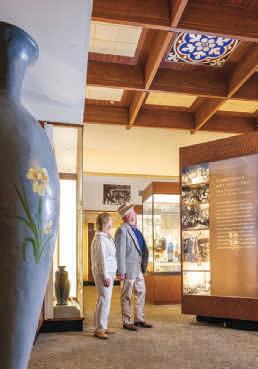

OHIO STORIES Zane Grey

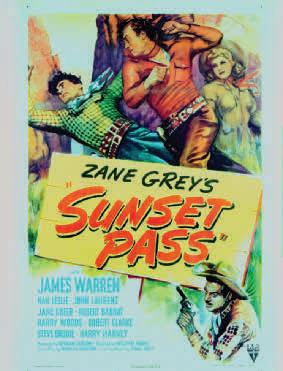
Zane Grey was a popular and widely read novelist of the American West.
Grey was born in Zanesville, Ohio, on Jan. 31, 1872. His parents were Lewis Grey and Alice Josephine Zane Grey. As a teenager, Grey was an excellent baseball player. He won a baseball scholarship to the University of Pennsylvania, where he studied to become a dentist. Once he left school and began his dental practice in New York, Grey realized that he was not happy. He decided to leave dentistry behind and become a writer.
Traveled West
Grey’s first novel, Betty Zane, drew inspiration from the stories he had heard about frontier Ohio when he was growing up. He wrote Betty Zane in 1904 but was not able to find a publisher at first. Refusing to give up, Grey traveled west and continued writing. In 1910, he had his first success when Harper’s Magazine published The Heritage of the Desert. Two years later, Harper’s published Riders of the Purple Sage.
Grey married Lina Elise Roth, called Dolly, in 1905. The couple had three children: Romer, Betty and Loren.
After publication of The Heritage of the Desert, the family moved to Altadena, California. Grey also had a hunting lodge in Arizona. Each year, Grey spent time traveling in the West and fishing in the Pacific. He then would return home and spend time writing.

Wrote Almost 90 Books
Grey died unexpectedly of a heart attack on Oct. 23, 1939. By the time of his death, he had written almost 90 books. Most of his books were Westerns, but he also wrote nine books that had a fishing theme. Grey also published many short stories, a biography of George Washington as a young man and several stories for children. Some of Grey’s other popular Western novels included The Spirit of the Border, Desert Gold, The Last Trail, The Call of the Canyon and The Thundering Herd.
This biography is from Ohio History Central, our online encyclopedia of Ohio history. Discover many more stories of Ohio history at ohiohistorycentral.org
Ohio History Connection










